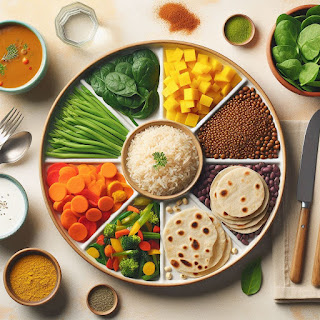Bridging Gaps in Nutrition: How to Build a Diabetes-Friendly Plate
When it comes to managing diabetes, one of the most powerful tools you can use is right on your dining table. The key is to create balanced meals that nourish your body while keeping your blood sugar levels stable. This World Diabetes Day, with the theme "Breaking Barriers, Bridging Gaps," let's dive into how we can bridge the gaps in nutrition by learning to build a diabetes-friendly plate using everyday Indian ingredients.
The Power of a Balanced Plate
Creating a balanced plate is one of the simplest and most effective strategies for managing diabetes. The idea is to fill your plate with foods that provide a steady release of energy, keep you full for longer, and help prevent those unwanted blood sugar spikes.
The Diabetes Plate Method:
Imagine your plate divided into three sections:
Half of the Plate: Non-starchy vegetables (fiber-rich)
One-Quarter of the Plate: Lean protein sources
One-Quarter of the Plate: Healthy carbohydrates
Below, we’ll guide you through each section using traditional Indian foods to help you create nutritious, diabetes-friendly meals.
Fill Half Your Plate with Non-Starchy Vegetables
Non-starchy vegetables are low in calories but rich in fiber, vitamins, and minerals. They help slow down digestion, which can prevent sudden spikes in blood sugar levels.
Examples of Indian Non-Starchy Vegetables:
Leafy Greens: Spinach (palak), fenugreek leaves (methi), drumstick leaves (murungai keerai)
Cruciferous Vegetables: Cauliflower (gobi), cabbage, Radish
Other Veggies: Bottle gourd (lauki), ridge gourd (turai), brinjal (baingan), capsicum
Tips to Include More Vegetables:
- Add a side of Porial or kootu or Avial
- Include a bowl of vegetable salad with cucumber, tomatoes, and carrots, dressed with lemon juice and chaat masala.
- Prepare a hearty vegetable soup using a mix of non-starchy vegetables for a filling, fiber-rich starter.
Fill One-Quarter of Your Plate with Lean Proteins
Protein is crucial for maintaining muscle mass and stabilizing blood sugar levels. Including lean protein sources in your meals helps control hunger and reduces cravings.
Examples of Indian Protein Sources:
Plant-Based: Dal (lentils), chickpeas (chana), moong dal, soya chunks, tofu, and paneer
Animal-Based: Eggs, fish and lean chicken
Tips for Adding Protein:
- Make a comforting bowl of dal tadka using moong or masoor dal paired with brown rice or rotis.
- Include sundal as a protein-packed snacks
- Opt for a paneer bhurji or grilled fish with a sprinkle of spices for a satisfying protein boost.
Fill One-Quarter of Your Plate with Healthy Carbohydrates
Carbohydrates often get a bad reputation among diabetics, but the type of carbs you choose makes all the difference. Whole grains and complex carbohydrates are digested slowly, helping to maintain stable blood sugar levels.
Examples of Indian Healthy Carbohydrates:
Whole Grains: Brown rice, millets (like jowar, bajra, and ragi)
Legumes: Rajma (kidney beans), moong dal, black-eyed peas
Whole Wheat: Roti, multigrain paratha, or wheat flour dosa
Tips for Healthy Carbs:
- Replace white rice with brown rice or millet varieties
- Opt for whole wheat rotis or bajra rotis instead of refined flour chapatis.
- Prepare a multigrain dosa using a mix of whole grains and legumes for breakfast.
Additional Tips for a Diabetes-Friendly Plate
Add Healthy Fats in Moderation: Healthy fats improve satiety and nutrient absorption. Include a teaspoon of ghee, Gingelly oil, or coconut oil in your meals. Add nuts like almonds and walnuts as a crunchy garnish.
Stay Hydrated: Proper hydration is key to controlling blood sugar levels. Opt for herbal teas, jeera water, or lemon water instead of sugary beverages.
Limit Processed Foods and Sugars: Focus on whole, unprocessed foods and avoid refined sugars. If you crave something sweet, have a piece of dark chocolate (70% cocoa or more) or a bowl of mixed berries.
Mind Your Portions: Even healthy foods can cause blood sugar spikes if consumed in large quantities. Use a smaller plate to control portions, and eat slowly to listen to your body’s hunger cues.
A Sample Diabetes-Friendly Plate (Indian Style)
Here’s an example of how you can put together a nutritious, balanced meal:
Half Plate: Mixed vegetable curry and a fresh cucumber-tomato salad.
One-Quarter Plate: A bowl of moong dal or grilled fish seasoned with spices.
One-Quarter Plate: A serving of brown rice or 2 small bajra rotis.
Add-On: A small bowl of curd (dahi) with a sprinkle of roasted cumin powder.
Bridging Gaps for Better Health
Incorporating these diabetes-friendly meal planning strategies can help break barriers to better health. By embracing the foods we’ve grown up with—like dal, veggies, and whole grains—we can effectively bridge the gap between tradition and health management.
This World Diabetes Day, let's take a step towards healthier eating, one plate at a time. Remember, small, consistent changes can have a big impact on your health and well-being.











No comments:
Post a Comment